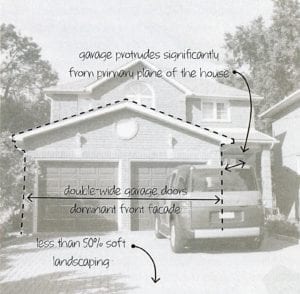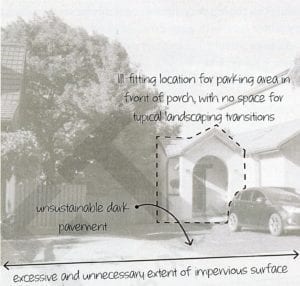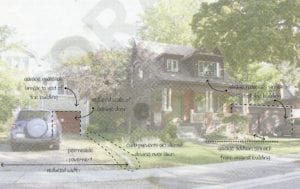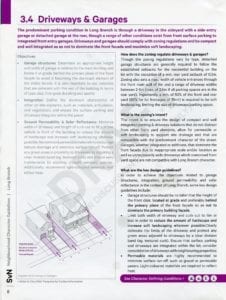Pages 8 & 9 of Feb. 7, 2017 Long Branch Guidelines Draft focuses on 3.4 Driveways & Garages
Update:
A more complete and highly informative overview of the contents of the Feb. 7, 2017 Long Branch Urban Design Guidelines Draft Document is available at the website of Ward 6 Councillor Mark Grimes. We owe thanks to Councillor Grimes for the role that he and his office have played in the initiation and development of the Pilot Project.
Click here to access the overview at the Ward 6 Councillor’s website >
[End]
Previous posts, in a series related to the Draft Guidelines Reference Material (f0r discussion purposes only), include:
Urban Design Guidelines Pilot Project has been launched in Long Branch – June 28, 2016
How to read the streets of Long Branch: Urban Design Guidelines Pilot Project is now underway – July 12, 2016
Long Branch Guidelines Pilot Project: David Godley shares his version of an Illustrated Analysis Grid – Aug. 11, 2016
Advisory Group for Long Branch Urban Design Guidelines had a productive meeting on Feb. 7, 2017 – Feb. 7, 2017
Pages 2 & 3 of Guidelines Draft: Exmoor Drive above TTC Loop is now included in Long Branch Guidelines project – Feb. 8, 2017
Pages 4 & 5 of Feb. 7, 2017 Long Branch Guidelines Draft focuses on 3.2 Height & Massing – Feb. 9, 2017
Pages 6 & 7 of Feb. 7, 2017 Long Branch Guidelines Draft focuses on 3.3 Building Elements – Feb. 10, 2017
Focus Questions
I have previously shared a detailed set of questions, that members of the Advisory Group were asked to comment upon at the Feb. 7, 2017 Advisory Group meeting. Time remains, at the time of this writing, for such comments to be sent to the Guidelines Pilot Project team. If you have any comments (or questions) please contact Sabrina Salatino directly by email at Sabrina.Salatino@toronto.ca
A short version of the list of questions reads:
1. Do you have any suggested refinements to the Long Branch Character Framework Plan?
2. What do you like about the draft guidelines? How could they be improved?
3. Are there any additional guidelines we should consider?
4. Do you have any suggestions for the approach / format for the public meeting?
A public meeting about the Long Branch Guidelines will be held in future.
3.4 Driveways & Garages
The introduction to pages 8 & 9 of the Draft Reference Material reads:
The predominant parking condition in Long Branch is through a driveway in the sideyard with a side-entry garage or detached garage at the rear, though a range of other conditions exist from front surface parking to integrated front entry garages.
Driveways and garages should comply with zoning regulations and be compact and well integrated so as not to dominate the front facade and maximize soft landscaping.

Diagram of Driveways & Garages. Note below image reads: Refer to City-Wide Template for further information. Source: Long Branch Draft (for discussion purposes only) Reference Material, Feb. 7, 2017, page 8
The Objectives for 3.4 Driveways & Garages read:
- Garage structures: Determine an appropriate height and width of garage in relation to the main building and locate it at grade, behind the primary plane of the front facade to avoid it becoming the dominant element of the entire facade. It is also important to use materials that are coherent with the rest of the building in terms of type, size, fine-grain detailing and quality
- Integration: Define the dominant character(s) of other on-site elments, such as materials, articulation, and vegetation, and ensure the surface parking and driveways integrate within the parcel
- Ground Permeability & Solar Reflectance: Minimize width of driveway and length of curb cut to fit just one vehicle in front of the building to reduce the amount of hardscape and increase soft landscaping wherever possible. Recommend permeable materials to encourage natural drainage and minimize surface run-off. Protect any green areas in proximity to driveways by requiring a clear division band (eg. textured curb) and ensure easy maintenance by planting drought resistant species. Additionally, recommend light-coloured materials that reflect heat.
*
Click on the images to enlarge them; click again to enlarge them further
*
On page 8 of the Reference Material you will find the following additional text:

Figure 75. Incompatible double-wide integrated garage condition. Source: Long Branch Draft (for discussion purposes only) Reference Material, Feb. 7, 2017, page 9
How does the zoning regulate driveways & garages?
Though the zoning regulations vary by type, detached garage structures are generally required to follow the established setbacks for the residential building on the lot with the exception of a min. rear yard setback of 0.3m.
Zoning also sets a max. width of vehicle entrances through the front main wall of 6m and a range of driveway widths between 2-6m (max. of 2.6m if all parking spaces are in the rear yard). Importantly, a min. of 50% of the front and rear yard (60% for lot frontages of 15m >) is required to be soft landscaping, limiting the size of driveways/parking space.

Figure 76. Incompatible front surface parking condition. Source: Long Branch Draft (for discussion purposes only) Reference Material, Feb. 7, 2017, page 9
What is the zoning’s intent?
The intent is to ensure the design of compact and well integrated parking & driveway solutions that do not distract from other front yard elements, allow for permeable or soft landscaping to support site drainage and that are compatible with the predominant character of the street.
Garages, whether integrated or additions, that dominate the front facade due to inappropriate scale and/or location as well as unnecessarily wide driveways which overcrowd front yard space are not compatible with Long Branch character.
What are the key design guidelines?

Figure 77. New house with well integrated garage beside older house with garage addition. Source: Long Branch Draft (for discussion purposes only) Reference Material, Feb. 7, 2017, page 9
In order to achieve the objectives related to garage structures, integration, ground permeability and solar reflectance in the context of Long Branch, some key design guidelines include:
- Garage structures should be no taller that the height of the front door, located at grade and preferably behind the primary plane of the front facade so as not to dominate the primary building
- Limit both width of driveway and curb cut to 6m or less in order to reduce the amount of hardscape and increase soft landscaping wherever possible. Clearly delineate the limits of the driveway and protect any green areas adjacent to driveways by a clear division band (e.g. textured curb). Ensure that surface parking and driveways are integrated within the lot; consider consolidation of driveways with neighbouring properties.
- Permeable materials are highly recommended to minimize surface run-off, such as gravel or permeable pavers. Light-coloured materials are required to reflect heat.
A note at the page bottom reads:
See Character Defining Conditions > d., e., f., i.
Please note: I’ve broken longer paragraphs into shorter ones, for ease in online reading.


Leave a Reply
Want to join the discussion?Feel free to contribute!